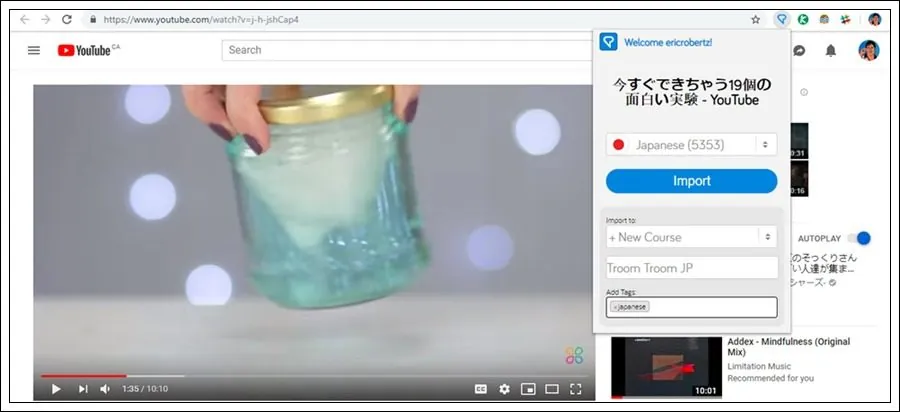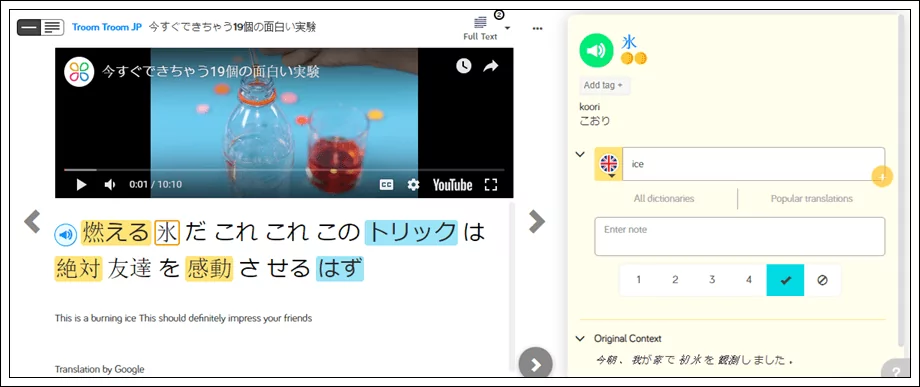Immerse Yourself by Watching Japanese YouTubers
One of the really cool things about learning a language is that, eventually, it becomes a source of entertainment rather than a long grind of slowly memorizing kanji or working your way through a textbook. The vast majority of Japanese speakers, after all, are Japanese people who are living their lives in Japanese. No matter what you want to study or what sort of content you’re interested in consuming, you can also do this in Japanese.
We’ve already talked a bit about what listening comprehension consists of, but recognize that It can be difficult to break into content and find a first channel you like. To that end, here’s a big list of popular Japanese YouTubers in a variety of categories to get you started.
Personal Vlogs
Russian Sato is a tiny girl with a huge appetite. She posts mukbang videos, a Korean phenomenon that basically amounts to cooking and eating large amounts of food while chatting with viewers. These videos are great because there are literally a ton of them and they all focus on one person. Eventually you get used to their way of speaking, meaning that you can spend more time focusing on the Japanese and less on deciphering the sounds you’re hearing. If you like this style of video, be sure to also check out Yuka Kinoshita!
Yusuke Okawa is a Japanese creative all about self expression. His channel is hard to succinctly define – it’s part lifestyle vlog, part travel vlog, part Adobe Premiere tutorial and the remainder is dedicated to anything to do with photography and videography. That being said, every single video is high-quality: excellent video, excellent editing, nice music and good content to boot. If you do any video editing or just want to learn how to take a nicer picture, learn how to do it in Japanese with Yusuke.
Kazu runs a blog documenting his experience as a Japanese guy living and working in Shanghai. I like his blog because it’s a lifestyle blog where all of the focus is on life. Each video is a commentary on what happens in a day of Kazu’s life and a lot of ground is covered in each one: Sometimes you’re sitting in a cafe with him as he tries to figure out something on his phone, other times you’re walking the streets of Shanghai, sometimes you’re eating something and other times he talks about some differences between Japanese and Chinese culture.
Yosshi (DN-Ütube) is a buff Japanese dude from Japan currently living in Dubai where he documents his training and life. Similar to Kazu, his videos are mostly composites: in each one you get to see some of the progress he’s making in the gym, chat with him as he walks around the city, see what he eats and go to some parties. I’m personally not much of a workout guy (I don’t even lift, bro) but I like Yosshi’s channel for the language. He’s a very masculine guy and this comes out in his rougher style of speech.
Aoi is a super friendly Japanese girl who runs a blog that’s part fashion and part cosmetic. I’m including Aoi on this list because I personally find myself watching her videos even though I’m not actually all that interested in makeup. Aoi has a really engaging personality and often shoots from an angle where you only see her from the shoulders and up, creating an effect that’s less like watching a video and more like Skyping with a friend. If you are interested in makeup and fashion, Aoi is really good about breaking down all the products she uses and narrating everything she does.
もしもしゆうすけ is a very new series that is a bit different from the others on this list. Yuusuke is similar to other vloggers in that his videos consist of him walking around, talking and generally sharing his life, but he is unique in that he decided to make the series specifically as a resource to show off what everyday Japan and Japanese is really like. Each video is fully subtitled in Japanese (no kanji) and English, so if you haven’t been able to find a Japanese resource you can follow, try this one first!
News Channels
If you’re studying for the JLPT N2 or N1 but aren’t sure where to begin, adding SakurafbegSoTV to your routine is a good start. Sakura TV is a pretty formal channel where hosts discuss major news events both international and within Japan. The channel is chock-full of both the more professional vocabulary and grammar structures that you’ll be required to digest for these higher level tests, so if you’re at this level and looking for a place to practice, here you go!
On a lighter tone, heartwarming news by TomoNews JP is literally just that – a playlist full of small news stories that make you feel better about humanity. All of the videos are just a few minutes long, making them easy to digest, and they’re also fully animated, allowing your eyes to help you out if you miss a vocab word here and there. If you like the playlist, you’ll probably enjoy the rest of the channel, which is devoted to sensational news stories in general rather than politics.
Humor
バイきんぐ is, hands down, my favorite Japanese comedy troupe. Baikingu is a two person skit consisting of a boke, an airhead full of odd habits that does lots of absurd stuff, and a tsukkomi, the “straight man” who bears the brunt of the boke’s… boke-ishness. In each episode the pair take on a new profession, from chefs to detectives to construction workers, finding humor in everyday situations. If you like Baikingu, you’ll probably also like 東京03 (Toukyou 03).
アンジャッシュ is a more traditional manzai group and all of their humor is based on mutual misunderstandings where each comic has a different idea of what’s going on. In this video, for example, the man in the blue shirt has come for a job interview but the store manager has just gotten off the phone where he was informed that he would be dealing with another pickpocket. The situation escalates as each party becomes increasingly more perplexed by the other’s attitude.
So far as humor goes, 笑点 (shouten) is just about as old-school as it gets. This comical variety show began in 1966 and has aired every Sunday since, making it old as is, but its rakugo style goes way back. Think of Shouten as Whose Line is it Anyway? meets Cards Against Humanity – the show consists of a host who asks questions to six “storytellers”. If their response is witty (enjoyed by the host/audience), they gain seat cushions. If not, they lose them. Each contestant can answer as many times as they wish and the rarely-met goal is to achieve ten cushions.
To top the section off, here’s a one-off by the variety show 水曜日のダウンタウン (Wednesday’s Downtown) that features 小峠英二 (Eiji Kotouge), the tsukommi from Baikingu. In this episode he agrees to spend a week in which he is not allowed to eat or drink anything unless he goes out to meet or stumbles into a celebrity who has that food/drink in their name. For example, Eiji gets rewarded with a single cup of tea and water after meeting with one of the members of the comedy group 御茶ノ水男子.
Science
Troom Troom JP is part science and part DIY, a channel dedicated to small experiments that you can do at home. The videos are relatively high quality and uploaded regularly, which is great as is, but the channel features crystal clear and natural audio to boot. This is a great channel to start with if you’re a beginner!
Bright Side Japan is a pop-science channel that is both huge and well-funded, putting out regular videos on a wide variety of content that covers all areas of the scientific spectrum. Every video is quite sensational and very bingeable, meaning that you can very well settle down with some ice cream on a night that you should be doing homework instead but call it a productive study session. The wonders of language!
Karawakarabo is a newer channel that puts out videos related to biology and our bodies. The videos are co-created with a doctor and laid out in the form of a running presentation so that each new idea is accompanied by some sort of a visual. If you’ve ever wondered why cats do strange things or what would happen if you regularly consumed human flesh, for better or worse, this is the channel for you.
Gaming
Nephrite is a professional Japanese fortnite player who regularly uploads gameplays and stream footage. His edited video uploads are fairly diverse, featuring everything from 200 IQ plays to his thoughts on recent patches. If you play fortnite, be sure to check out other Japanese players like Neko Kun or Shouji.
We’ve actually already introduced you to Hikakin in another post, but he has multiple channels and the one shared earlier was dedicated to… well… generally buffoonery. Anyone who follows Hikakin knows that he loves gaming and, in particular, minecraft. Here’s his main Minecraft playlist, stuffed full of 369 videos, and a side playlist where he plays in survival mode. (Hikakin’s got enough content for a lifetime, but if you’re really into Minecraft, be sure to also check out Gaming Kazu).
The LoLeSportsJP channel is, just as the name implies, a channel covering cup-level professional League of Legends games. Riot also has an official LoL channel that includes official content videos (champion introductions) and interviews with Japanese professional players. For more standard gameplay content, be sure to check out Yomi, Sutanmi and Sharuru.
SANNINSHOW‘s channel, just as the name suggests, features three guys. These three guys get together to play all sorts of games across multiple platforms and eras, so if you’re not a fan of one particular game or just want a bit of variety, start here. Alongside the gaming content, they also do a podcast where they discuss anything and everything and have a series where they explore the world – by which I mean, our world.
Learn Japanese Faster Using LingQ
Immersing yourself in Japanese doesn’t require you to travel abroad or sign up for an expensive language program.
However, it can be a bit tiresome to find interesting content, go back and forth between sites, use different dictionaries to look up words, and so on.
That’s why there’s LingQ, the best way to learn Japanese online because it lets you learn from content you enjoy!
You can import videos, podcasts, and much more and turn them into interactive lessons. That includes the YouTubers I’ve mentioned above. Here’s how:
Download the LingQ extension for your browser and head over to YouTube. Once you’ve selected a video, simply click the LingQ extension and hit the import button. Within seconds, LingQ will import the video’s content (audio, transcript) and create an interactive lesson that you can read and listen to. It’s that easy.


Keep all your favourite Japanese content stored in one place, easily look up new words, save vocabulary, and review. Check out our guide to importing content into LingQ for more information.
LingQ is available for desktop as well as Android and iOS. Gain access to thousands of hours of audio and transcripts and begin your journey to fluency today.
Enjoyed this post? Check out polyglot and LingQ cofounder Steve Kaufmann’s YouTube video on how he learned Japanese!


